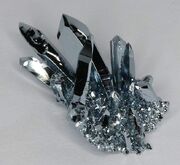
Osmium is a chemical element that has the symbol Os and atomic number 76. Osmium is a hard, brittle, blue-gray or blue-black transition metal in the platinum family, and is the densest natural element. Osmium is twice as dense as lead. The density of osmium is 22.61 g/cm3, slightly greater than that of iridium, the second densest element. Osmium is found in nature as an alloy, mostly in platinum ores.
Osmium is also used in alloys, with platinum, iridium and other platinum group metals. Those alloys are employed in fountain pen tips, electrical contacts and in other applications where extreme durability and hardness are needed.
Characteristics[]
Osmium is an extremely dense metal that remains lustrous even at high temperatures. Due to its hardness, brittleness, and very high melting point (the fourth highest of all elements), solid osmium is difficult to machine, form, or work. Osmium is generally considered to be the densest known element, narrowly defeating iridium. Calculations of density from the space lattice may produce the most reliable data for these elements, giving a density of 22.562±0.009 g/cm3 for iridium versus 22.587±0.009 g/cm3 for osmium. The extraordinary density of osmium is a consequence of the lanthanide contraction.
Osmium possesses quite remarkable chemical and physical properties. It has the highest melting point and the lowest vapor pressure in the platinum family. Osmium has a very low compressibility. Correspondingly, its bulk modulus is extremely high, reported between 395 and 462 GPa, which rivals that of diamond (443 GPa). However, the hardness of osmium is lower than diamond, only 4 GPa.
Osmium forms compounds with the oxidation states ranging from −2 to +8. The most common oxidation states are +2, +3, +4, and +8. The +8 oxidation state is notable for being the highest attained by any chemical element, and aside from osmium, is encountered only in xenon and ruthenium. The oxidation state −1 and −2 represented by the two reactive compounds Na2[Os4(CO)13] and Na2[Os(CO)4] are used in the synthesis of osmium cluster compounds.
The most common compound exhibiting the +8 oxidation state is osmium tetroxide. This toxic compound is formed when powdered osmium is exposed to air, and is a very volatile, water-soluble, pale yellow, crystalline solid with a strong smell. Therefore, osmium powder has a characteristic smell of osmium tetroxide. Osmium tetroxide forms red osmates OsO4(OH)2−2 upon reaction with a base. With ammonia, it forms the nitrido-osmates OsO3N−. Osmium tetroxide boils at 130 °C and is a powerful oxidizing agent. By contrast, osmium dioxide (OsO2) is black, non-volatile, and much less reactive and toxic.
Only two osmium compounds have major applications: osmium tetroxide — for staining tissue in electron microscopy and the non-volatile osmates for organic oxidation reactions.
Osmium heptafluoride (OsF7) and osmium pentafluoride (OsF5) are known, but osmium trifluoride (OsF3) has not been synthesized yet. The lower oxidation states are stabilized by the larger halogens. Therefore, the trichloride, tribromide, triiodide and even osmium diiodide are known. The oxidation state +1 is only known for the osmium iodide (OsI), whereas several carbonyl complexes of osmium, such as triosmium dodecacarbonyl (Os3(CO)12), represent the oxidation state 0.
In general, the lower oxidation states of osmium are stabilized by ligands that are good σ-donors (such as amines) and π-acceptors (heterocycles containing nitrogen). The higher oxidation states are stabilized by strong σ- and π-donors, such as O2− and N3−.
Value[]
The base value of each unit of ranges between 10 and 40Ð per unit, with up to 3 units being found at any one time.
Presence on Mars: Rare
| Martian Minerals | |
| Group 1 | Group 2 | Group 3 | Group 4 | Group 5 | Group 6 | |
| Group 3 | |Antimony | Astatine | Barium | Bismuth | Cesium | Francium | Hafnium | Indium | Iodine | Iridium | Lanthanum | Lead | Mercury | |Osmium | Platinum | Polonium | Radium | Radon | Rhenium | Tantalum | Tellurium | Thallium | Tin | Tungsten | Xenon| |